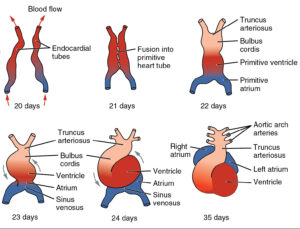Early embryonic hearts are amazing multitaskers, but when they first begin working, they don’t resemble the miniature four-chambered organs we might imagine. Despite this, early embryonic hearts lie at the crux of anti-abortion legislation prohibiting abortions after the so-called “fetal heartbeat” can be detected. The term ‘fetal heartbeat’ to describe early cardiac activity at six weeks is not medically or scientifically accurate.
Embryonic Hearts Are Fantastic Multitaskers
You probably wouldn’t recognize your own heart if you saw it when it first started functioning. As the first organ to begin working in a growing embryo, the heart starts off as a tiny, delicate, flexible tube. As the heart undergoes the magnificent transformation from simple valveless tube to four-chambered, valved, pumping powerhouse that keeps you alive, it beats the entire time, providing blood to the rest of the embryo.

This is no happenstance. When an embryo first forms, nutrients can diffuse freely throughout the embryo. As it grows and divides, it becomes too large and diffusion of nutrients is no longer sufficient to meet the needs of the growing embryo. Instead, a simple valveless tube called the linear heart tube forms and almost immediately starts contracting to deliver nutrients and carry away waste throughout the embryo.
Surprisingly, it’s through the forces generated by the blood flow inside this simple tube, along with the marvelously coordinated orchestration of molecular signaling, that the primordial heart tube loops and twists to form the complex chambered organ that sustains us. An embryonic heart actually uses the forces from the flowing blood it’s pumping to develop itself. In fact, the motion from blood flow is critical to the heart’s development, regulating details from valve sizes and vessel shape.
When blood flow is disrupted, development goes awry and congenital heart defects can occur. In fact, only about a third of congenital heart defects are caused by genetics. Scientists are just starting to realize how important physical cues generated from blood flow are to developing hearts. The embryonic heart is an incredible multitasker- pumping blood to supply the growing embryo with nutrients, oxygen, and carry away waste, while relying on the physical forces from the blood that it pumps as cues for its own development.
Contracting Embryonic Tube or Fetal Heartbeat?
Before the heart tube forms, clumps of early heart cells can produce spontaneous, uncoordinated jolts from burgeoning electrical activity that do not produce any blood flow through the embryo. Then the heart tube forms and contracts to carry nutrients through the embryo at about 6 weeks of pregnancy (based on the last menstrual period or 4 weeks post-fertilization). At 6 weeks of pregnancy, the pregnant person often may not even realize they’re pregnant. It’s not until around gestational week 10 that the developing heart forms valves or chambers. According to the American College of Obstetrics and Gynecology, heart chambers do not fully form until between 17-20 weeks of gestation.
Bills like the Texas heartbeat bill use misleading language not based in science or medicine, defining a ‘fetal heartbeat’ as “cardiac activity or the steady and repetitive rhythmic contraction of the fetal heart within the gestational sac.” including when clumps of early electrical cells start twitching. A fetal heartbeat doesn’t exist at 6 weeks, because a fetus doesn’t exist at six weeks – an embryo does. The embryo is not considered a fetus until at least 8 weeks into gestation. There are no heartbeats at 6 weeks, because no structure resembling a four-chambered heart exists at 6 weeks. These bills prohibit abortions as soon as their definition of a ‘fetal heartbeat’ is detected, typically by ultrasound. This effectively bans abortions as soon as 6 weeks and before many pregnant people know they are pregnant. The vague language written in these bills about medical emergency exceptions can endanger the lives of pregnant people experiencing medical emergencies or miscarriages since they can be denied or experience delayed medical care. By the time a woman living in Texas whose fetus had a fatal congenital defect was able to receive care outside of her state she required a hysterectomy from hemorrhaging.
Heartbeat bills also include misinformation, such as stating cardiac activity is a strong indicator for viability. Medical professionals do not use cardiac activity alone to determine fetal viability. It’s one of the many standards health care professionals use to check for pregnancy progress. Additionally, many states now have passed ‘informed consent’ laws which require pregnant persons seeking abortion to first read a pamphlet about abortions, often produced by the state and containing misinformation. According to the Informed Consent Project, which fact checks these pamphlets with a team of anatomists, over half of the statements about the first trimester of pregnancy in North Carolina’s informed consent manual are false.
The language used in these bills is designed to ‘tug at your heart strings’ with no regard for science or medical information. Over half of Americans think abortion should be legal depending on how far along the pregnancy is. These bills purposely obfuscate facts and appeal to emotions with misleading information that can shape public opinion on abortion and endanger lives.
Peer Editor: Nicole Gadda
Feature Image: Illustration by author created in Biorender